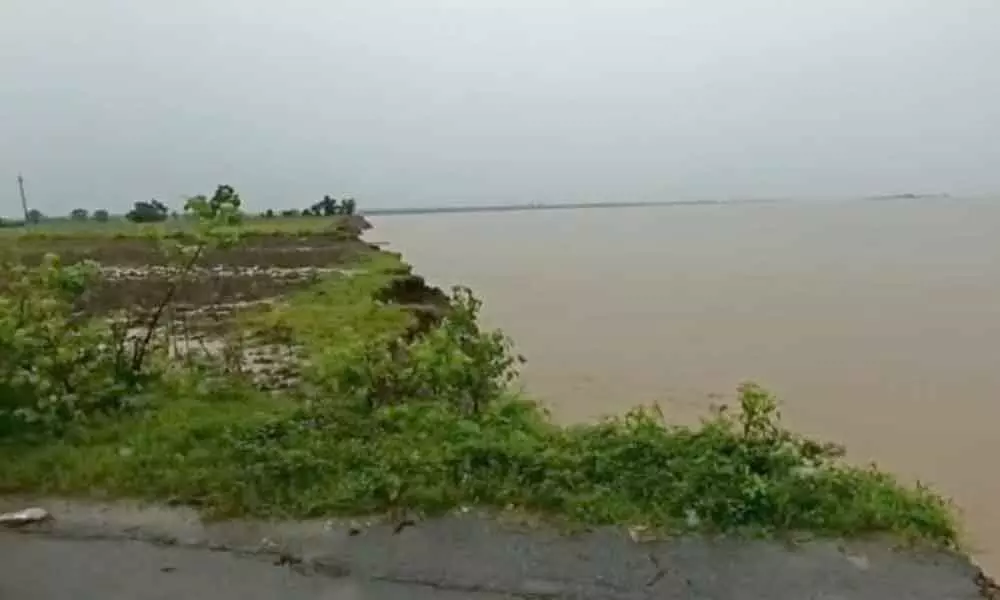Live
- Three persons admitted to hospital for diarrhea treatment
- First Star Outside Milky Way Captured: WOH G64 is 2,000 Times Larger Than the Sun
- Sikkim govt to constitute state Niti Ayog: CM Tamang
- CBI books Rajasthan narcotics inspector for Rs 3 lakh bribe
- Rajasthan bypolls: A tough contest between BJP and Congress
- Albania joins SEPA, paving way for EU integration
- Japanese government approves 250-billion USD economic package to ease price pain
- Six pharma companies to set up their units in Telangana
- The Unstable Events of a 17-Wicket Day in Perth: India vs Australia
- Dutch FM's Israel trip cancelled after Netanyahu's arrest warrant
Just In

The cropland inundated by the surging Godavari floodwaters near Podumuru village under Mangapet mandal in Mulugu district
Rain may have stopped now but the floodwaters in River Godavari that tripped its course surging into hundreds of acres of croplands still remained, giving a pale picture of those living in the countryside whose major subsistence is agriculture.
Mulugu: Rain may have stopped now but the floodwaters in River Godavari that tripped its course surging into hundreds of acres of croplands still remained, giving a pale picture of those living in the countryside whose major subsistence is agriculture.
The sewage swirls caused by the recent monsoon deluge in Warangal forced MA&UD Minister KT Rama Rao to visit the city and extend the government's support to the city-dwellers. But for the local Congress MLA Seethakka, there was none to console the hapless farmers, who lost their crops in the surging Godavari waters. Riverbank erosion is a major problem for the croplands in the floodplains of Godavari. It erodes croplands depositing sedimentation.
Although the farmers were encountering the phenomenon for ages, their grievance finally caught the eye of the government after that devastating Godavari floods in 1986 destroyed hundreds of acres of cropland and brought down many houses, displacing thousands of people in the tribal belt of Eturnagaram and Mangapet mandals.
In 2007, the then combined Andhra Pradesh government, which conducted a survey, has decided to construct 15-kilometer karakatta (embankment) dividing work into in five packages – Gangagudem 3.1 kms, Ramannagudem 5.6 kms, Kamalapuram 5.7 kms, including setting up of 11 outfall sluices (toomulu in local parlance), repairs to old karakatta etc. with an estimated cost of Rs 46 crore. However, the work on it didn't go smoothly due to hiccups in land acquisition. The government was able to acquire only 38 acres against the need of nearly 180 acres. As a result, the work on karakatta between Mangapet and Kamalapuram came to a halt.
The Central Designs Organisation and other experts who inspected the region in 2017 had expressed concern over the flood impact on riverbank villages. Following which the irrigation wing prepared a proposal with an estimated cost of Rs 128.56 crore. The proposal also suggested acquiring 315 acres so that permanent measures could be taken to avoid flooding and soil erosion. Since then, the government is yet to give a go-ahead to the works, in spite of the assurance given by the then Irrigation Minister T Harish Rao.
L Narasimha Rao of Podumuru village under Mangapet mandal said, "Floodwaters washed away my farmland. Even though the floods recede, the cropland is left with alluvial sedimentation. It takes a lot of hard work to remove the riverine sand dunes. With the government not taking measures to construct the karakatta, we are living under constant fear of facing floods." Godavari floodwaters surged into hundreds of acres of cropland between Mangapet and Akinepally Mallaram, he added.
Speaking to The Hans India, Mulugu MLA Seethakka said, "The embankment of Godavari is the only way that saves Adivasis from floods. From Devadula to Akinepally Mallaram, the tribal pockets are in distress whenever Godavari is in surge. I urge the Chief Minister K Chandrasekhar Rao to clear the embankment proposal file as early as possible."

© 2024 Hyderabad Media House Limited/The Hans India. All rights reserved. Powered by hocalwire.com







